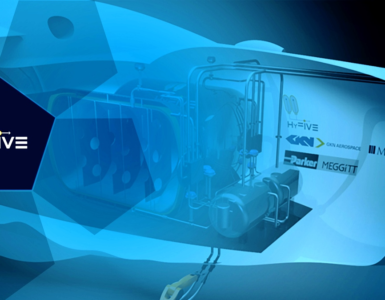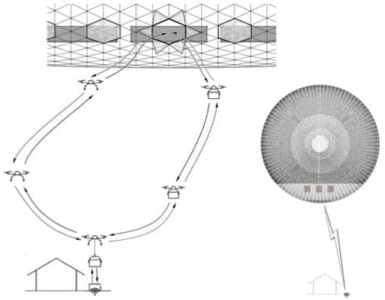Yocova: Behind Airbus early-stage hydrogen glider emissions and warming research.
Yocova, an end-to-end platform for innovation in aviation, reveals the latest news regarding emissions research.
The road to hydrogen-powered aircraft requires many technology bricks, and as Airbus focuses on the 2035 deadline for its ZEROe hydrogen project, a key brick is researching in detail the emissions from hydrogen combustion at altitude.
To that end, as an early-stage project, Airbus is launching Blue Condor, a pair of propelled gliders that will conduct research in 2023.
🔥 What about we co-host a webinar? Let's educate, captivate, and convert the hydrogen economy!
Hydrogen Central is the global go-to online magazine for the hydrogen economy, we can help you host impactful webinars that become a global reference on your topic and are an evergreen source of leads. Click here to request more details
Yocova had the chance to speak with Sabine Klauke, Airbus’ chief technology officer, and Sandra Bour Schaffer, head of Airbus demonstrators and the chief executive officer of Airbus’ demonstrator hub UpNext, during and after the project’s reveal.
Bour Schaffer explains:
Contrail characterisation is of significant interest to Airbus.
“We know that hydrogen emits no carbon dioxide when burned, but we also know that with water vapour and heat being the most significant by-products, hydrogen combustion does produce contrails.”
“Although these contrails differ significantly to those produced by conventional JetA and A1 combustion engines, understanding their composition will be key.”
What are the differences between burning kerosene (fossil and SAF) and hydrogen in the atmosphere?
Key to direct hydrogen combustion as a future technology at the core of aviation is understanding how the non-carbon emissions from hydrogen-burning engines affect the atmosphere, and how this differs from kerosene.
Non-carbon emissions from fossil fuel kerosene include oxides of nitrogen (commonly referred to as NOx), soot, oxidised sulphur, and water vapour. These create additional warming effects, whether directly or indirectly (like the additional insolation from contrails), some of which are magnified further by altitude.
Most of the more sustainable aviation fuels, or SAFs, behave in similar yet subtly different ways to fossil fuel kerosene. Some SAFs, for example, contain less sulphur — a challenge to overcome for enginemakers who have relied on sulphur aromatics to make certain seals swell in older engines, but a benefit on the emissions side.
When it comes to hydrogen, airframers have two options: one is to burn hydrogen directly in the engine, while the other is to power aircraft via hydrogen fuel cells.
On the direct hydrogen combustion side, Bour Schaffer tells Yocova, “today’s theory tells us that there is no CO2 emission. There are some NOx. We believe that is no soot. We know — we think — there is much more water vapour. This is what we believe today, but the measurements will be capable of telling us what is the exact content.”
Bour Schaffer estimates that there could be 2.5 to 2.6 times the amount of water vapour emitted from hydrogen combustion.
Critical questions around all these emissions, she says, include “what is the proportion of each of them? What does it mean, in the near field? What does it mean in the far field? What is the persistence of the contrails? These are all the questions we would like to have an answer to.”
The project’s goals are multiple, Bour Schaffer tells Yocova, including that “this demonstrator will be the opportunity for us at Airbus to fly, for the first time ever, a hydrogen-burned engine.”
It is, Bour Schaffer says, a “simplified engine. It’s not the kind of engine that will propulse our zero emission aircraft in 2035. But it’s sufficiently representative for us to understand what are the contrails and to measure the different particles.”
The reason “why this demonstrator is so important is because we will be able to have a precise and detailed understanding of the different characteristics of the contrails,” she notes.
Blue Condor: three aircraft, three phases
The Blue Condor project involves three aircraft. The first two are a pair of Arcus-J gliders (technically jet sailplanes), one with a conventional kerosene engine and one modified with a hydrogen combustion engine.
The hydrogen glider will be modified by teams working with the atmospheric research Perlan Project, which itself uses a glider as its research aircraft and which achieved the subsonic altitude record in 2018.
Given that hydrogen is substantially less dense than kerosene, the rear pilot seating in the glider will be replaced by two 700-bar hydrogen tanks that will power the hydrogen combustion turbojet engine.
The third aircraft is a Grob Egrett plane from the German aerospace research centre DLR, which will measure the emissions from both the Blue Condor gliders in quick succession, in similar atmospheres.
Sabine Klauke, CTO tells Yocova said:
Is the same aircraft that we used, as well, for our tests that we did with sustainable aviation fuel, and it’s adapted to what we measure now.
The project has three phases. The first, in mid-2022, will see the first flight of the modified glider, validating the new platform and its configuration, as well as testing flight handling under real-world conditions.
In November, the second phase will see the glider operating on hydrogen alone. In early 2023, the chase plane will, Airbus says, “steer the two gliders to the test altitude, release them, and then mirror their every movement at speeds of 80-85kts during back-to-back tests.”
“We need to much more understand and the actual impacts of the different propulsion technologies in the atmosphere. It’s about CO2 reduction, it’s about overall emission reduction,” she continues.
“We know far less about NOx or contrails, and this is what we want to study and what we want to understand. I think it’s also important that we will be able to compare that to the measurements that we’ve actually done, today, with standard kerosene with the SAF, in the different models that we’ve already flown.”
This comparison will be achieved by conducting back-to-back tests in the same meteorological conditions above the skies of North Dakota. The University of North Dakota, which has a strong aerospace science department, is one of the project collaborators.
Indeed, notes Klauke, this closer working with academia is intentional on Airbus’ part, not least given that substantial research is needed for so many of the technology bricks.
“We’re talking with many universities, and specifically on the models. We are talking to MIT, we are talking to Cranfield University, for instance, and Cambridge. So all the different centres of excellence which are there, and we are really, as well, wanting that academia is going forward because we need more knowledge.”
About Yocova
Yocova is an end-to-end platform for innovation: digital infrastructure and services to facilitate the exchange of ideas, data, and apps in aviation. The platform is structured around the pillars of Community, Data Rooms and Marketplace:
- Community: the global aviation community on one open and trusted platform – connect and collaborate with aviation peers in public forums and private working groups
- Data collaboration: a decentralised, secure, and voluntary data API exchange giving you full control of who accesses your data to support your digital initiatives
- Marketplace: a trusted ‘go to’ aviation marketplace for digital transformation – find, try, buy, and deploy leading digital aviation apps, data API’s solutions and services, or sell and manage your own through a global route-to-market
For OEM partners, Yocova provides a single command and control platform through which to securely distribute, authenticate, and update all digital content across the customer community. For OEM customers, a single entry-point for swift, efficient user access to all OEM digital content.
Yocova continues to pursue its growth strategy at pace with over 1000+ members extending across the aviation value chain, including but not limited to professionals and enterprises from airlines, business jet operators, digital/data vendors, through to airports, ANSPs and OEMs.
READ the latest news shaping the hydrogen market at Hydrogen Central
Yocova: Behind Airbus’ early-stage hydrogen glider emissions and warming research, LONDON, September 15, 2022








